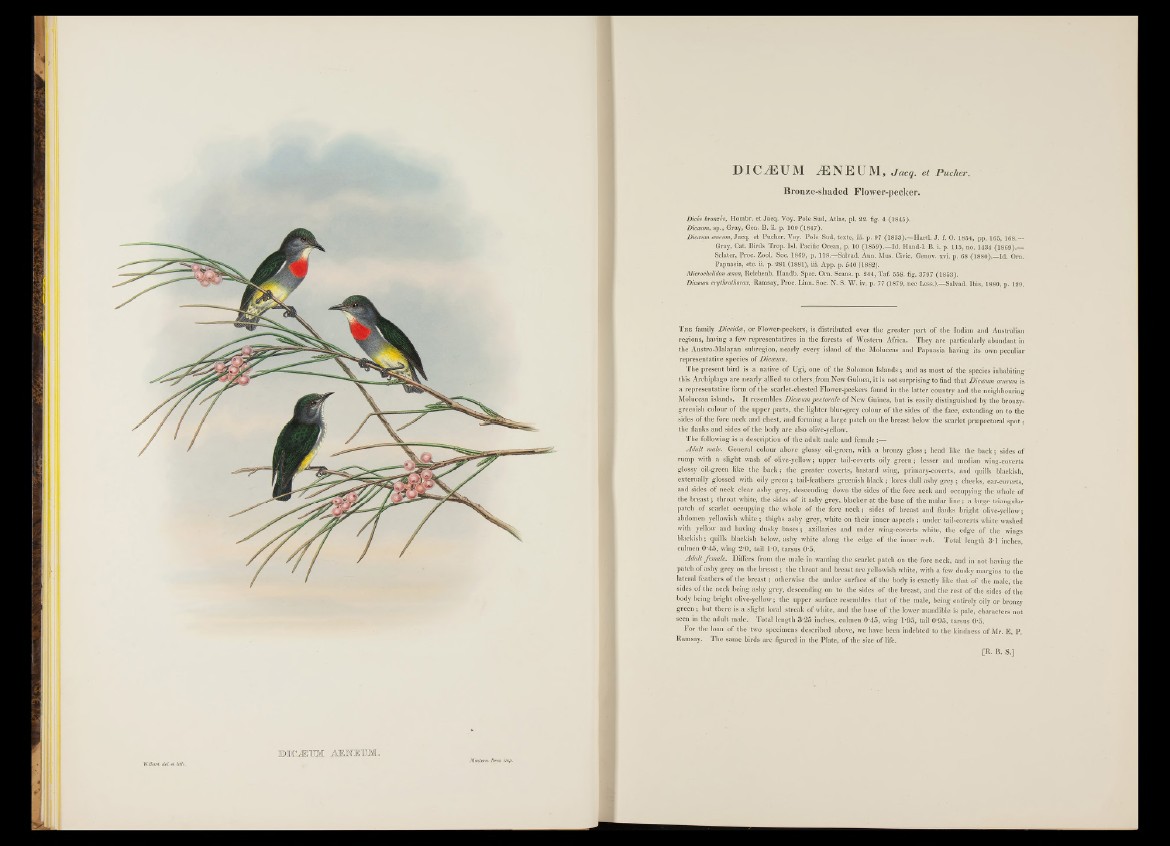
Minterns Bros. imp.
DICÆUM ÆNEUM, Jacq. et Pucker.
Bronze-shaded Flower-pecker.
Dicee bronzee, Hombr. et Jacq. Voy. Pole Sud, Atlas, pi. 22. fig. 4 (1845).
Dicaum, sp., Gray, Gen. B. ii. p. 100 (1847).
Dicaum ceneim, Jacq. et Pucher. Voy. Pole Sud, texte, iii. p. 97 (1853).—Hartl. J. f. 0 . 1854, pp. 165, 168.—
Gray, Cat. Birds Trop. Isl. Pacific Ocean, p. 10 (1859).—Id. Hand-1. B. i. p. 115, no. 1434 (1869).—
Sclater, Proc. Zool. Soc. 1869, p. 118.—Salvad. Ann. Mus. Civic. Genov, xvi. p. 68 (1880).—Id. Orn.
Papuasia, etc. ii. p. 281 (1881), iii., App. p. 540 (1882).
Microchelidon anea, Reichenb. Handb. Spec. Orn. Scans, p. 244, Taf. 558. fig. 3797 (1853).
Dicaum erytJirothorcus, Ramsay, Proc. Linn. Soc. N. S. W. iv. p. 77 (1879, nec Less.).—Salvad. Ibis, 1880, p. 129.
T he family Diceidce, o r Flower-peekerS, is distributed over the greater part o f the Indian and Australian
regions, having a few representatives in the forests o f Western Africa. They are particularly abundant in
the Austro-Malayan subregion, nearly every island ò f the Moluccas and Papuasia having its own peculiar
representative species o f Dicceum.
The present bird is a native o f Ugi, one o f the Solomon Islands ; and as most o f the species inhabiting
this Archiplago are nearly allied to others from New Guinea, it is not surprising to find th at Dicceum ceneum is
a representative form o f the scarlet-chested Flower-peckers found in the latter country and the neighbouring
Moluccan islands. I t resembles Dicceum pectorale o f New Guinea, but is easily distinguished by the bronzy-
greenish colour of the upper parts, the lighter blue-grey colour o f the sides o f the face, extending on to the
sides of the fore neck and chest, and forming a large patch on the breast below the scarlet prmpectoral spot ;
the fianks and sides o f the body a re also olive-yellow.
The following is a description o f the adult male and female :—
Adult male. General colour above glossy oil-green, with a bronzy gloss ; head like the back ; sides of
rump with a slight wash o f olive-yellow ; upper tail-coverts oily green ; lesser and median wing-coverts
glossy oil-green like the back ; the g reater coverts, bastard wing, primary-coverts, and quills blackish,
externally glossed with oily green.; tail-feathers greenish black ; lores dull ashy grey ; cheeks, ear-coverts,
and sides o f neck clear ashy grey, descending down the sides o f the fore neck and occupying the whole of
the breast ; throat white, the sides o f it ashy grey, blacker a t the base o f the malar lin e; a large triangular
patch o f scarlet.occupying the whole o f the fore neck; sides o f breast and Hanks bright olive-yellow;
abdomen yellowish white ; thighs ashy grey, white on their inner aspects ; under tail-coverts white washed
with yellow and having dusky bases ; axillaries and under wing-coverts white, the edge o f the wings
blackish; quills blackish below, ashy white along the edge o f the inner web. Total length 3-1 inches,
culmen 0*45, wing 2*0, tail l'O, tarsus 0*5.
Adult female. Differs from the male in wanting the scarlet patch on the fore neck, and in not having the
patch o f ashy grey on the breast ; the throat and breast are yellowish white, with a few dusky margins to the
lateral feathers o f the breast ; otherwise the under surface o f the body is exactly like th at o f the male, thè
sides o f the neck being ashy grey, descending on to the sides of the breast, and the res t o f the sides o f the
body being bright olive-yellow ; the upper surface resembles that o f the male, being entirely oily or bronzy
green ; but there is a slight loral streak o f white, and the base o f the lower mandible is pale, characters not
seen in the adult male.. Total length 3 '2 5 inches, culmen 0*45, wing 1*95, tail 0-95, tarsus 0-5.
For the loan of the two specimens described above, we have been indebted to the kindness o f Mr. E. P.
Ramsay. The same birds are figured in the Plate, o f the size o f life.
[R. B. S.]